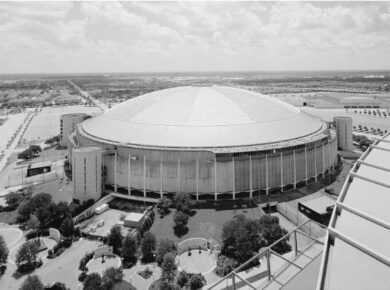German modernism at its best.
Egon Eiermann (29 September 1904 – 20 July 1970) was one of Germany’s most prominent architects in the second half of the 20th century. He was also a furniture designer. Since 1947, he was Professor for architecture at the Technical University of Karlsruhe.

Photo: Sven Oujla / Wikimedia
He studied architecture at the TU of Berlin. From 1931 to 1945, he was an independent architect in Berlin and initially planned residential buildings. He joined the faculty of the Technische Hochschule Karlsruhe in 1947, working there on developing steel frame construction methods. During a study trip to the United States in 1950, he met Walter Gropius, Marcel Breuer and Konrad Wachsmann. During the years of reconstruction, his steel-frame industrial buildings became exemplary.

Photo: saai, Eberhard Troeger
The expression and culmination of this liberation from everything that had come before, are the steel constructions that characterize Egon Eiermann’s work in both architecture and furniture design. He picked up on Bauhaus design principles in his designs. The permeability of the intermeshing of the inside and outside, nature and constructed space became an expression of democracy in architecture as well as in furniture design.

Photo: Germanbo
With its reduction to the line, the reflection on pure form and liberation from overflowing accessories, Eiermann achieves a modesty in his designs that seems to free his objects from historical contexts while still presenting them as a consistent continuation of what came before.

photo © IL
His major works include: the West German pavilion at the Brussels World’s Fair in 1958; the Embassy of Germany, Washington, D.C.; the high rise Langer Eugen for the German Parliament in Bonn; the IBM-Germany Headquarters in Stuttgart and the Olivetti building in Frankfurt. By far his most famous work is the new church on the site of the Kaiser Wilhelm Memorial Church in Berlin.
About the Author:

Bruno Dursin – Managing Director at Believe in Steel. Bruno has more than 30 years of experience in promoting steel & steel solutions. His clients benefit from his extensive network within the building industry.



